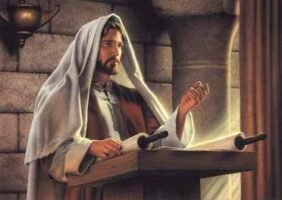Tetzaveh from a Messianic Perspective

Exodus 27:20-30:10
Torah Portion Tetzaveh is nestled within the Book of Exodus, focusing on the roles and responsibilities tied to the consecration of the priests, especially Aaron and his sons. What stands out is the depth of detail regarding priestly garments and the symbolic meaning woven into every stitch. This portion not only sets forth guidelines for attire but also provides a spiritual blueprint that highlights purity and devotion.
Tetzaveh emphasizes the priestly garments, like the ephod, breastplate, and robe, each embedded with imagery and function that serve specific purposes in the Tabernacle. These aren’t just pieces of clothing; they are integral to the service rituals and reflect a deeply sacred intent. Each garment’s colors and materials weren’t chosen randomly—they are imbued with holiness and purpose, reinforcing the priest’s role as a mediator between the divine and the people.
The instructions on fabricating the Tabernacle and its elements signal a beacon of sanctity and faith, demanding precision and reverence. With an array of commandments centered around the lampstand and the altar, Tetzaveh highlights the importance of keeping the light of faith burning strong and the continuous offering of gratitude and commitment. This serves as a reminder of the ever-present need for spiritual awareness and connection.
There’s a richness in Tetzaveh that urges readers to ponder its message and the significance of preparation and presentation in their own spiritual paths. The emphasis on the ordination process of Aaron and his sons points to a bigger picture of dedication and the setting apart of individuals for a holy task. This foundational aspect of service resonates, calling us to look at how we prepare for our relationships with the divine in our lives.
Messianic Insights: Finding Messiah Yeshua in Tetzaveh
In Tetzaveh, the presence of Messiah Yeshua is subtly, yet powerfully, infused through symbols and rituals. The garments of Aaron aren’t just ceremonial outfits; they whisper the role of Yeshua as our eternal High Priest. The intricate details in the ephod and breastplate can be viewed as a tapestry of His sacrifice and redemption—Yeshua, clothed in righteousness, intercedes for us just as Aaron did for Israel.
But because he lives forever, his position as cohen does not pass on to someone else; and consequently, he is totally able to deliver those who approach God through him; since he is alive forever and thus forever able to intercede on their behalf.
(Hebrews 7:24-25 CJB)
The anointing of Aaron with oil becomes a reflection of how Yeshua, the Anointed One, stands as a spiritual bridge. This act of pouring oil signifies consecration and sacred appointment, drawing a parallel to Yeshua’s own anointing to His divine mission. By understanding this, one can grasp the deeper connection between the priesthood and the Messiah, strengthening faith in Yeshua’s sacrifice and role.
Each element of the Tabernacle, so meticulously described, can be seen aligning with Yeshua’s teachings. The lampstand’s light, ever-burning, evokes the light Yeshua brings into our lives, dispelling darkness. The altar signifies sacrifice, pointing directly to the greatest sacrifice of all. Observing these connections helps followers of Yeshua appreciate the fulfillment of these symbols in His life and service.
Yeshua spoke to them again: “I am the light of the world; whoever follows me will never walk in darkness but will have the light which gives life.”
(John 8:12 CJB)
Seek out these patterns and symbols as reminders of Yeshua’s constant love and advocacy. Understanding Tetzaveh with this perspective allows for a deeper appreciation of scriptural continuity and enriches the spiritual journey, opening hearts to the majesty of Yeshua’s enduring presence and purpose.
Living the Message: Life Applications for Followers of Yeshua
Understanding Torah Portion Tetzaveh can deeply enrich one’s spiritual life by offering insights into practical holiness. It calls believers to bring the symbolism into the everyday—fostering a life that reflects the principles of faith and dedication.
The careful design of priestly garments serves as a reminder to don virtues and commitment daily, seeking a purity of heart and actions that resonate with Yeshua’s teachings. As these garments were made for divine service, one is encouraged to live each day with purposeful intent, aligning actions with spiritual values.
Engaging with the concept of anointing, consider how dedication in personal lives can reflect the sanctified service seen in the Tabernacle. Whether through acts of kindness, prayer, or community involvement, this provides a way to offer oneself to Yeshua, fostering a heart ready for His work.
Maintaining the ‘lampstand’ of faith involves continual nurturing of one’s spiritual light through study, prayer, and community. Keeping this light shining bright amidst life’s challenges echoes the perpetual flame tended by the priests, underscoring the need for steadfastness in belief and practice.
A call to embrace the underlying message of connectedness and dedication found in Tetzaveh encourages living a life that testifies to Yeshua’s enduring legacy. It’s about inviting others to see that reflection of divine service, encouraging them to explore their relationship with Yeshua through tangible acts of love and service.
Dale Solberg is a guest writer at Messianic Torah Portion offering a commentary and devotional thoughts from a Messianic Perspective on each week’s Torah reading. His views and opinions do not necessarily reflect those of The Messianic Light. You can reach Dale at dale@messianictorahportion.com.
Unless otherwise noted, Scripture quotations are taken from the Complete Jewish Bible, Copyright © 1998 and 2016 by David H. Stern. Used by permission. All copyrights reserved worldwide.
This post contains affiliate links. Purchases help support Messianic Torah Portion and do not affect the price you pay. Please do not make purchases on the Sabbath.
Messianic Torah Portion is a ministry of The Messianic Light.

Comments
Tetzaveh from a Messianic Perspective — No Comments
HTML tags allowed in your comment: <a href="" title=""> <abbr title=""> <acronym title=""> <b> <blockquote cite=""> <cite> <code> <del datetime=""> <em> <i> <q cite=""> <s> <strike> <strong>